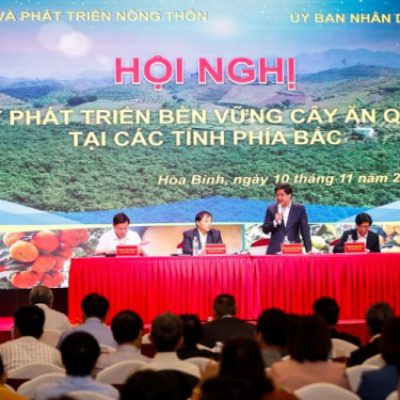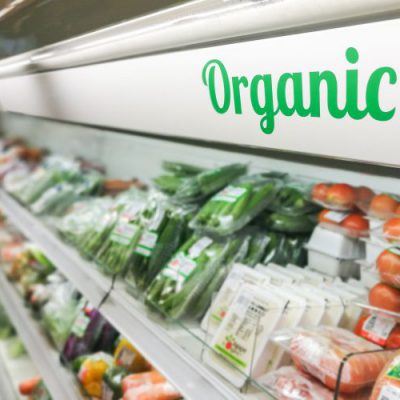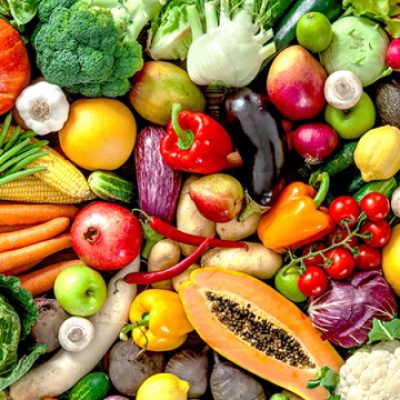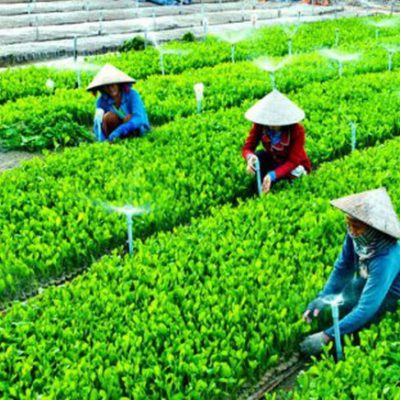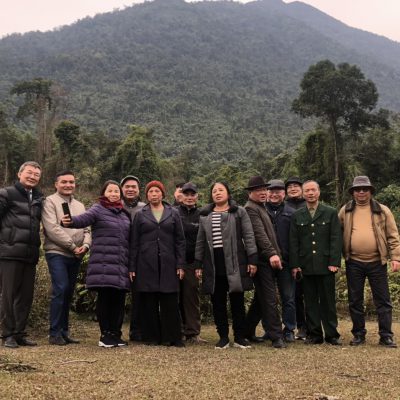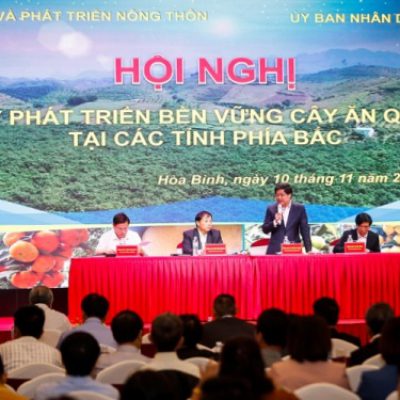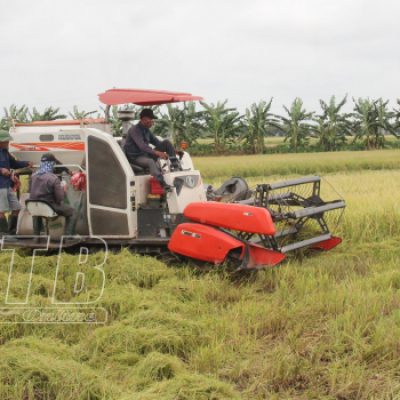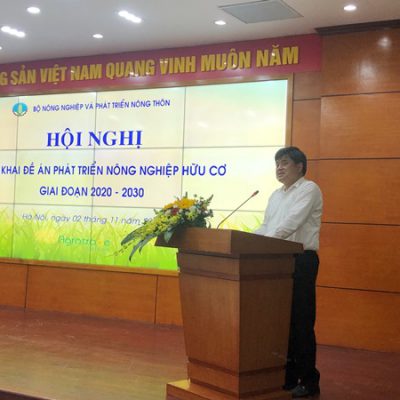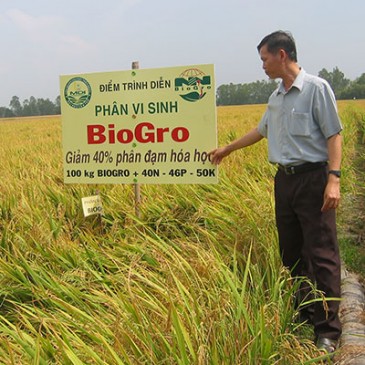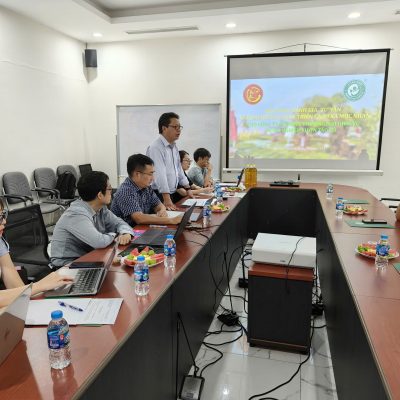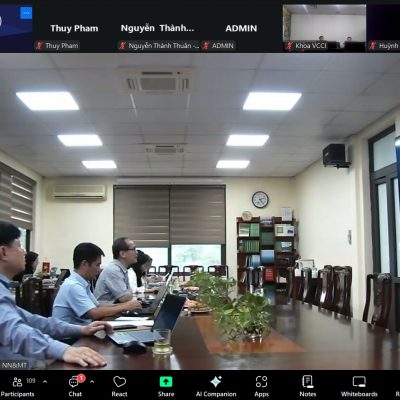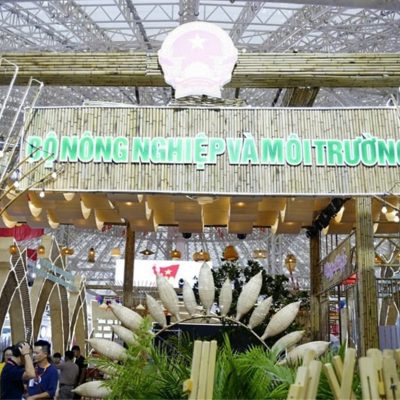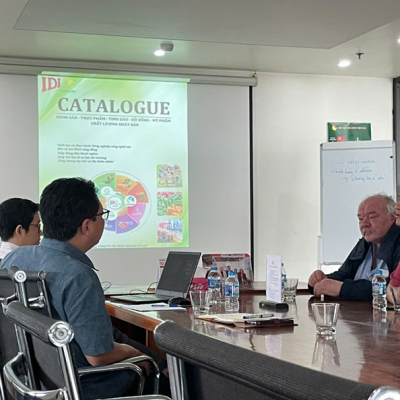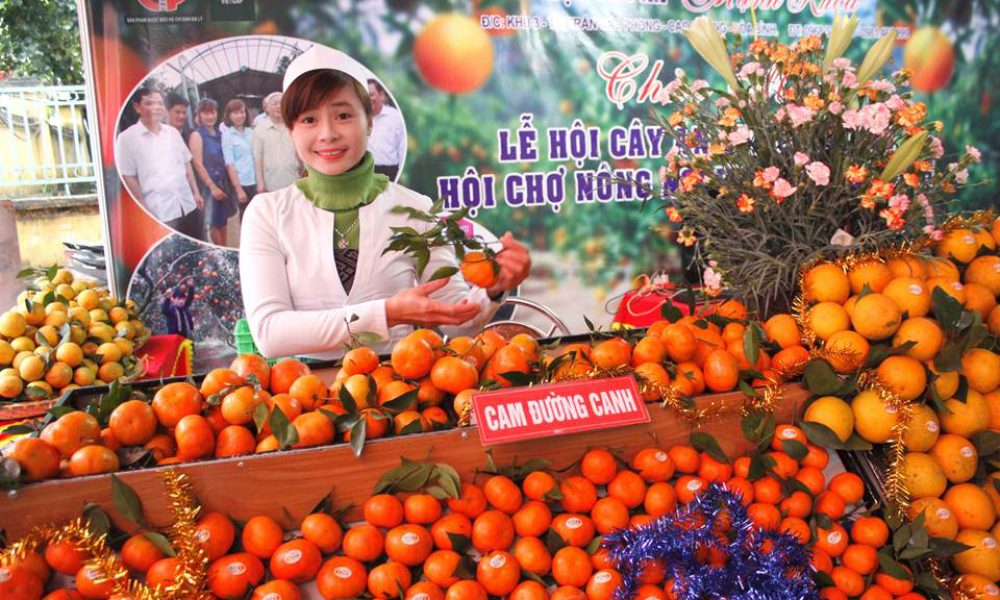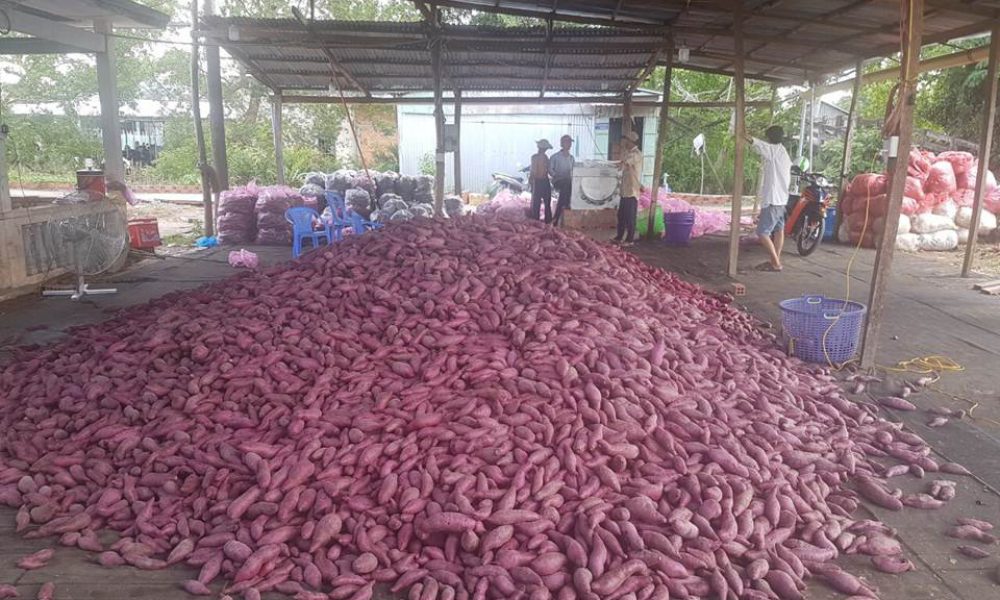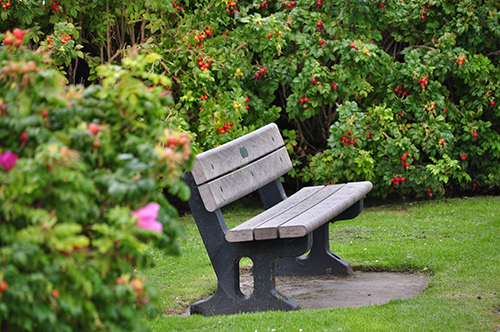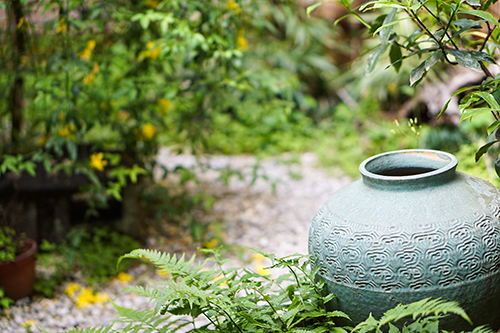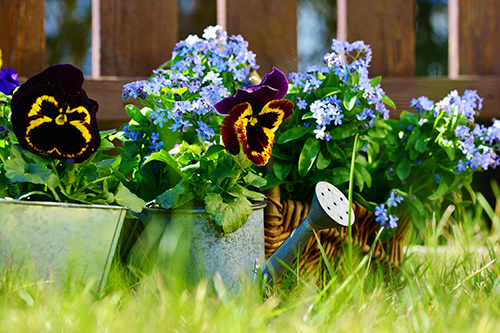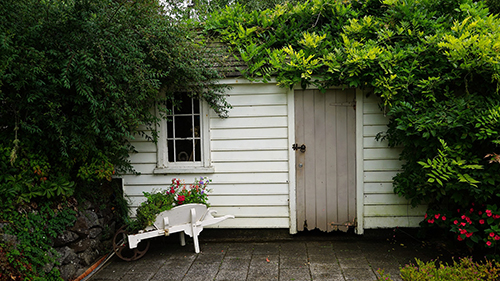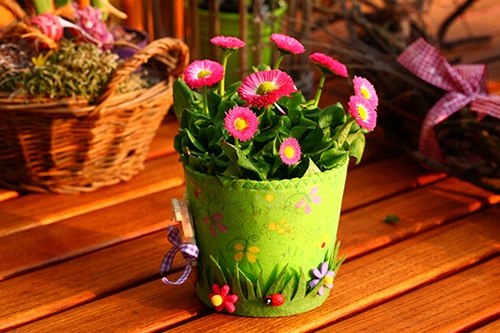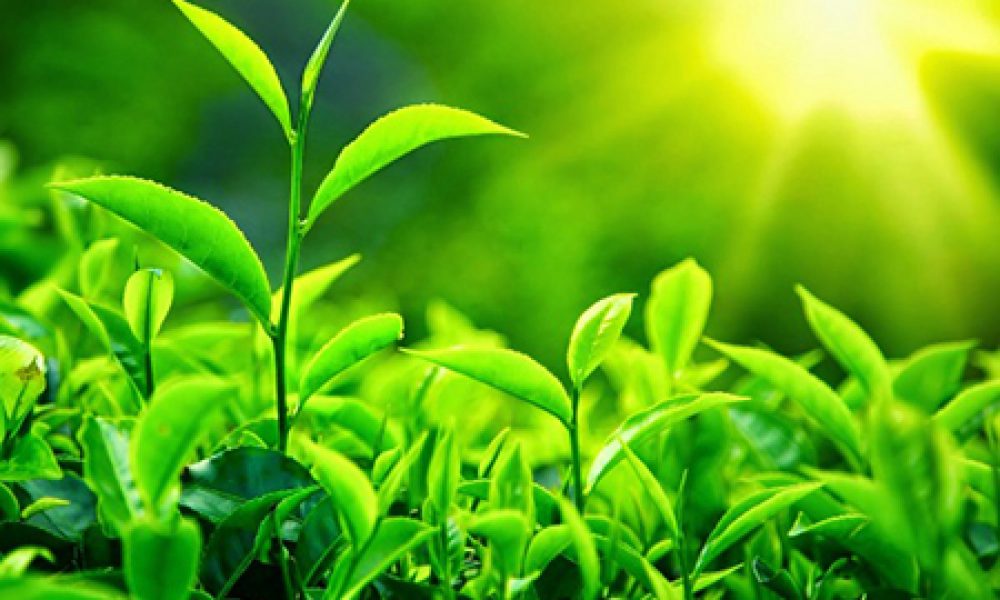
Meeting on Sustainable Development of Citrus in Northern Provinces
Day 10/11, in Hoa Binh, Ministry of Agriculture&Rural Development coordinated with the Provincial People's Committee to organize a conference to promote sustainable development of citrus (CAQCM) in the northern provinces. Attending and chairing the conference were Deputy Minister of Agriculture&Rural Development Le Quoc Doanh; Deputy Secretary of the Provincial Party Committee, Provincial People's Committee Chairman Bui Van Khanh; Provincial People's Committee Vice Chairman Dinh Cong Su. There are also departmental leaders, branches of the province and representatives of the Department of Agriculture&PTNT 22 the provincial.
According to the report of Department of Crop Production (Ministry of Agriculture and Rural Development), Up to now, in many localities, concentrated commodity citrus production zones such as Ha Giang oranges have been formed, Peace, Bac Giang, Phu Tho grapefruit, Bac Giang, Peace, Tuyen Quang, Bac Kan and Lang Son tangerines.
The total area of citrus trees in the northern mountainous provinces is approximately 121.000 he has (accounting for 47,5% area of the country).
Remarkable, Citrus area has been steadily increasing in recent years, with high growth. Statistics in 10 five words 2009 – 2019, Citrus growth averaged 10% / year in terms of area (equivalent 7,3 thousand hectares / year), on 12% in terms of output (69,4 thousand tons).
Along with area growth, Quantity, Citrus production in the Northern mountainous provinces still has many limitations and many difficulties in product consumption., Disease. Besides, abuse of inorganic fertilizers and chemical pesticides, risk of soil pollution, country, outbreaks and quality problems.
At the conference, The delegates contributed many papers on the production situation, the citrus pest situation, orientation of plant protection and market opening, processing industry, Promotion of citrus fruits; synthesis of research results, transfer of seed technical advances, culture, post-harvest in recent years and the future orientation ...
Speaking at the conference, Deputy Secretary of the Provincial Party Committee, Provincial People's Committee Chairman Bui Van Khanh emphasized: Lately year, The province's agricultural production forms key product groups, to create a reputation in the domestic market and towards export. The province has completed the land suitability classification map for crop production with the classified area 116 thousand hectares. Especially, CAQCM is a key crop in the process of agricultural restructuring of the province. To the year 2020, the whole province has approx 11.500 he has. Inside, Business area approx 7.400 he has; 2.119 ha of citrus trees were certified for food safety, VietGAP, Organic. Expected year 2020, the income value per unit of cultivated area is above 350 million / ha. Besides the results achieved, CAQCM production in the province still has some limitations, exists as: Business status, trade in seeds of unknown origin, Quality failures are still going on; applied techniques have not been synchronous; many new pests and diseases arise; preservation activities, preprocessing, undeveloped processing; The issue of protecting trademarks and intellectual property rights has not been paid attention.
Provincial People's Committee Chairman Bui Van Khanh proposed to the Ministry of Agriculture&Rural Development and relevant sectors support the province to review citrus; area code level; increase trade promotion, looking for export markets; transfer of preservation technology, product processing CAQCM. At the same time, support the province to implement the project of replanting Cao Phong orange area.
Concluding remarks Conference, Deputy Minister of Agriculture and Rural Development Le Quoc Doanh acknowledged the efforts and achievements in CAQCM development of the Northern provinces. Deputy Minister confirmed: Production of citrus trees, an important role in agricultural restructuring. Before the difficulties, Shortcomings still exist, recommended departments, service, the set, Central departments need to closely coordinate with localities to synchronously deploy solutions to develop sustainable citrus, well implement the planning of planting areas.
The Deputy Minister suggested the Department of Crop Production preside over and guide the localities to review, to adjust the area of citrus trees according to planning. For the Plant Protection Department, concentrate on directing the prevention, against harmful diseases; issue a process to control Greening and yellow leaf disease, root rot. The National Agricultural Extension Center gives priority to the development of model gardens. The institutes have well implemented the plant breeding program of the Ministry of Agriculture&PTNT…
Source: Ministry of Agriculture and Rural Development
Organic product verification method
A European project is leading the way in strengthening consumer confidence in organic produce, with the creation of an intuitive system for better transparency in the organic supply chain.
Besides, The COVID-19 pandemic seems to have had a major impact on people wanting to choose healthier foods.. Demand for organic products is clearly increasing, This is great news for organic farmers, But what happens when demand exceeds supply? Using electric heating bulb/photography is the best, results are deficient and / or increase prices sharply. It also creates opportunities for those who want to cheat and sell conventional products as organic.
With modern supply chains, complex, It is often difficult to know where the exact product is coming from – and unfortunately, Some ignorant people may exploit this. Laboratory testing to distinguish organic from conventional is also a very difficult task. In addition to filing for pesticides or fertilizers, The "organic test" in the lab is almost impossible.
How to verify organic products?
An innovation is expected to be sponsored by the European Institute of Food-Technology and Innovation (EIT-food) may have developed an answer to the organic verification challenges.
As part of this process, an international group, Led by the Institute for Global Food Security at Queen's University Belfast, has mapped and digitized the two organic supply chains – one for red meat and one for fresh produce. Experts from Cambridge University, Siemens, ABP and Colruyt worked closely together to achieve this groundbreaking work. By creating a digital twin of the key elements in the chain, they can get a better overview of the supply chain – A useful tool for retailers. This approach also empowers consumers, help them gain insight into their food's origins.
In terms of measurement science, Researchers from the Institute for Global Food Security have collaborated with experts from the Fraunhofer Institute to look at innovative ways to determine whether fresh meat and produce from organic and conventional systems can distinguished by whether or not “food fingerprinting technology” is used. The results were impressive; Using very rapid forms of mass spectrometry has shown great promise, with the rate of successful separation from 90% come 100%. The research team is also trying to use a handheld device to perform the same method; Results from this will be ready later this year.
Another important part of the project is engagement with key stakeholders and consumers in the organic sector. A series of meetings and workshops were held to engage and discuss the findings of this study. Initial results from a large-scale Europe-wide survey have shown that by introducing traceability technology into the organic food chain, Consumer confidence increased. Not only do they consider it more secure and less susceptible to fraud, but they are also willing to pay a premium for these guarantees.. The consumer and stakeholder work has been developed by a multidisciplinary team of experts from across European universities, including Hohenheim University, The University of Turin and the Queen's University of Belfast.
The results of this project will bring about paradigm change, shows that organic supply chains can become more transparent through the use of innovative science and digital technologies..
Source: Ministry of Agriculture and Rural Development
The survey shows an increase in vegetable consumption during the pandemic
This study is believed to be the first multi-continental study to be conducted on the effects of COVID-19 on eating habits..
Positive changes such as increased home cooking and cooking from scratch with fresh ingredients have been recorded. However, There are also negative trends, for example, an increase in saturated fat intake is reported.
Bulk purchases spiked – put pressure on food systems that are already stressful and can lead to shortages, causing further panic purchases – Also observed during the study.
The survey was carried out during the period from month to month 5 to month 6 year 2020, when many countries are embargoed and using the template 2.360 adults in four regions – island of Ireland, Brother, America and New Zealand .
General, The survey found less change in food behavior in the US compared with the other three regions, and the most significant regional differences occurred between the US and elsewhere.. For example, An increase in vegetable intake was demonstrated in all regions except the United States. There is also an increase in the frequency of home cooking and baking at home in all regions except the United States.
Parents cooking (and baking) The same offspring were also found to be increased in all samples except the United States (Interestingly, research shows that parents who bring their children into the preparation of family meals more often have higher dietary quality.).
Opposite, An increase in saturated fat intake was seen everywhere except the United States.
General, there was a decrease in take-away food consumption and an increase in 'food organizing practices'. (planning ahead, Shop with grocery list, v.v.). When it comes to "food management practices" (prepare in advance, cook in batches, v.v.), there are no obvious changes for Ireland or New Zealand. This may be related to the fact that the Irish and New Zealand restrictions are stricter than in other regions., so there may be less need to prepare food in advance.
“These findings don't just provide vital data on how our behaviors and food systems have adapted to pandemic., but also has public health implications as we continue to strive to manage COVID-19 with continuous containment and restriction measures ”, team leader – Dr. Fiona Lavelle from IGFS said about the project,.
“We want to understand the impact of the pandemic and the shutdown on people's health, but we also want to try to figure out how to measure the impact on the global food system..
“Thank you very much, There is some good news in our findings and many people have benefited from cooking more at home and eating a wider range of fresh foods.. But there are also some red marks in it, such as an increase in saturated fat consumption, can be reduced to ‘comfortable eating’ during the blockade. It is very important – especially during a pandemic, for obvious reasons – to maintain a balanced diet, nutritious.
“One of the survey results that interests me the most is the increase in cooking with children, This is good for kids – but our research highlights potential positive benefits to the quality of a parent's diet when children are involved ”.
“With the blockade continuing and there will probably be more people working from home in the future, I believe that bringing kids into cooking activities will be a key public health message in the future. ”
Research by the Institute of Global Food Security (IGFS) at Queen's partnership with St Angela's College, Sligo (part of the National University of Ireland, Galway) leader. The main findings have been published in the journal Nutrients and the team believes that this is the first study published on multiple continents about changing food practices by COVID-19..
Source: Ministry of Agriculture and Rural Development
Approve selected scheme, complete, Replication of a new and effective cooperative model in localities across the country in the period 2021 – 2025
Day 03/02/2021, The Prime Minister signed Decision No. 167 / QD-TTg approving the selected project, complete, replicating an effective new cooperative model in localities across the country in the period 2021 – 2025.

The overall goal of the Project is to provide a practical basis for a new, efficient cooperative that contributes to a successful implementation of the path, policy of the Party, law of the State; Building cooperative models to become models for propaganda, raise awareness and create attraction to people, organization, participating businesses, link with cooperatives; As a basis for the replication of new models of cooperatives operating effectively in many fields, promote the collective economic sector, development cooperatives nationwide. Whereby:
The Scheme's point of view:
– Build, Organization of the implementation of the project "Selection, complete, replicating an effective new cooperative model in localities across the country in the period 2021 – 2025"In accordance with the Party's policy line, State law and international treaties to which Vietnam has committed.
– Mobilizing synchronous supporting policies, existing resources of the State and society to implement the Scheme, creating a breakthrough for the cooperatives in terms of organization and operational efficiency.
– Respect for the basic organizational principles of voluntariness, free, self-responsibility, promote internal strengths of the cooperative. The state does not intervene, impose administrative orders on organizational work, operating and production and business activities of cooperatives.
Detail goal (to year 2025):
– Choose to be minimal 300 participating cooperatives / unions of cooperatives, works according to 12 model of the Scheme;
– 100% pilot cooperatives with high efficiency, rated Good, reach words 80 points or more according to Circular No. 01/2020/TT-BKHĐT day 19/02/2020 of the Ministry of Planning and Investment on guidelines for the classification and evaluation of cooperatives (hereinafter referred to as Circular No. 01/2020 / TT-BKHDT);
– Develop a plan to replicate effective new cooperative models nationwide 05 next year (stage 2026 – 2030).
Subjects of implementation are cooperatives, Cooperative unions are operating effectively nationwide, wishing to participate in the Scheme, are local, Selection, the conditions for participation are met. The number of participants is approx 300 cooperatives across the country, in that each province, centrally selected cities 05 Cooperatives participating in the Scheme. Time to implement the Scheme: including 03 stage: Stage 1: Select a pilot cooperative model (in year 2021); Stage 2: Completion of the pilot model, Replication of a number of completed new cooperative models (to date 30/06/2025); Stage 3: summary, propose plans to replicate effective new cooperative models (6 the last month of the year 2025).
The selected cooperative models complete
– For the agricultural sector, cooperative production model, just entered the market (agricultural product trading floor); Co-operative model accumulation, concentrating land on a large scale and applying high technology to production; Agricultural cooperative model to undertake input services, preliminary processing / processing and the output in the value chain of agricultural products; Cooperative model to respond to climate change; Cooperative model for sustainable agricultural, forestry and fishery development; Model of cooperatives producing OCOP products, associated with rural tourism, mountain range; Participating business model is a member of cooperatives producing and processing agricultural, forestry and aquatic products; Fishing cooperative model, aquaculture and protecting community resources.
– For the non-agricultural sector, cooperative construction activities model; Transportation cooperative model; Handicraft cooperative model associated with restoration and development of traditional craft villages; Model of service cooperatives for the community (environmental activities, medical, education, market manager…).
Responsibilities of the Ministry of Agriculture and Rural Development:
– The focal point to guide the coordination and integration of the Scheme implementation into the programs, other agricultural development projects in accordance with the production planning and the restructuring plan of the agricultural sector;
– Coordinate with the Ministry of Planning and Investment to support localities in formulating plans, scheme to support agricultural cooperatives, check the implementation situation; summary, evaluating the results of the scheme's implementation, propose a plan to replicate the effective agricultural cooperative model in the next period./
Source: Ministry of Agriculture and Rural Development
Promote export of fruit to Japanese market
Day 12/1, At Hanoi, Deputy Minister of Agriculture and Rural Development (NN&PTNT) Le Quoc Doanh had a working session with Mr. Vu Hong Nam, Vietnamese Ambassador to Japan.

At the meeting, Deputy Minister Le Quoc Doanh said: Last time, Japanese projects have provided great support to Vietnamese agriculture in developing agricultural value chains, infrastructure upgrades, promote private investment, strengthening human resources, environmental Protection, respond to climate change.
Deputy Minister Le Quoc Doanh emphasized: The issue of market access for Vietnamese agricultural products to the Japanese market is very important. Vietnamese litchi products are currently highly appreciated by the Japanese market. Although the volume of Vietnamese lychee exported to Japan is not much, it has created a good effect.
Regarding the plan to open the market for Vietnamese longan fruit, Currently the Japanese side is conducting a pest risk analysis. The two sides are trying to speed up the technical exchange so that Vietnam can soon export fresh longan to Japan.
About the potential to export grapefruit to Japan, Deputy Minister Le Quoc Doanh said: Phu Tho province has the same specialty pomelo variety Doan Hung with an area 1.500 he has, productivity 124 quintal / ha, Quantity 15.004 tons / year. Doan Hung grapefruit has been issued by the Department of Intellectual Property – The Ministry of Science and Technology grants the annual protection title to geographical indications 2006; year 2015, Doan Hung grapefruit product is 1 among 59 High quality agricultural product brand was honored with "Agricultural Gold Brand 2014".. The Plant Protection Department is currently negotiating to export Doan Hung grapefruit to major markets like Japan, China, America.
Ambassador Vu Hong Nam said: Vietnam - Japan relations are currently developing very well, This creates a favorable foundation for the export of Vietnamese agricultural products to the Japanese market. Increasing agricultural exports will help domestic farmers change the way of production in the direction of further improving quality and added value., so that Vietnamese agricultural products can penetrate into difficult markets.
According to the Ambassador, Vietnamese grapefruit has the prospect of exporting to Japan due to the low pest risk of pomelos. Besides that, Japan does not have this fruit. The ambassador said: Some Vietnamese fruits are not on the Japanese quarantine list, This list needs to be published for businesses to understand, thereby increasing fruit exports to Japan.
The ambassador said, Currently, the preservation stage of Vietnam's agricultural exports is still not good, so some Vietnamese agricultural products exported to the Japanese market are still not well-designed.. The Ambassador suggested to the Ministry of Agriculture&Rural development needs to propose an overall plan, Which fruit has potential to enter the Japanese market will take the necessary steps to export that fruit.
Deputy Minister Le Quoc Doanh expected Ambassador Vu Hong Nam to act as a bridge, strengthening cooperation between state management agencies of the two Ministries&Rural Development in two countries, supporting human resource training at the Center at Can Tho University, Vietnam Academy of Agriculture.
Source: Ministry of Agriculture&PTNT
To restore agricultural production in the Central region after the annual natural disaster 2020
Pm 26/11, The delegation of the Ministry of Agriculture and Rural Development, headed by Minister Nguyen Xuan Cuong, visited, direct the restoration of production after storms and floods in a number of localities in Quang Tri province.
The delegation checked the implementation of field improvement activities, canals were filled after floods in Trieu Giang commune, Trieu Phong district; visit and stock fish at Truc Kinh Fish Farm, Gio Linh district; visit the "brood chicken" model at the experimental farm of Quang Tri Agricultural College; check activities to overcome landslides in Gio Hai commune, Gio Linh district.
On this occasion, to support Quang Tri province to restore agricultural production, soon stabilize people's lives, The Ministry of Agriculture and Rural Development awarded: 1.100 bird; 300 tons of animal feed; 740 million for veterinary medicine; 1.500 carp, tilapia, The broodstock are ready to breed at the beginning of the year 2021 with approx 15-16 million seeds for farmers… The total value of this technology transfer and support is close 1,2 billions dong.
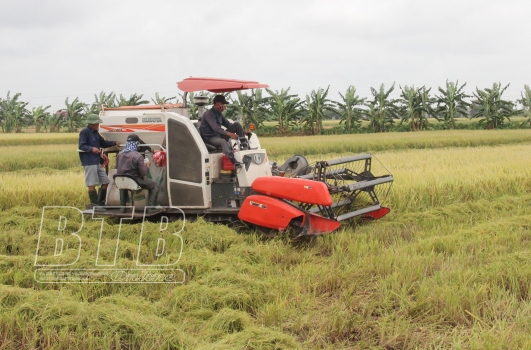
In the process of going to the actual inspection, overcoming consequences of storms and floods in localities, Minister Nguyen Xuan Cuong highly appreciated the efforts of the government and people of Quang Tri in recent years. The province has put all efforts early to mobilize forces to overcome the consequences of storms and floods to stabilize people's lives. Minister Nguyen Xuan Cuong said that the most important job now is to focus on the reconstruction of infrastructure, Irrigation works combine with forces to clear canals, clearing the land covered by sand to prepare for the upcoming winter-spring crop. Especially, to create livelihoods for the people from now until the Lunar New Year through the promotion of vegetable cultivation and short-term husbandry. Besides that, The province prepares the best seed and materials for successful production in Winter-Spring crop 2020-2021 to compensate for the loss of the relatives. Thereby, production soon, economic for the people in the long run. Minister Nguyen Xuan Cuong also suggested that Quang Tri province need to study and deploy the options soon, coastal protection solutions in areas suffering from erosion towards sustainability in response to climate change.
Ministry of Agriculture&PTNT
Meeting on Sustainable Development of Citrus in Northern Provinces
Day 10/11, in Hoa Binh, Ministry of Agriculture&Rural Development coordinated with the Provincial People's Committee to organize a conference to promote sustainable development of citrus (CAQCM) in the northern provinces. Attending and chairing the conference were Deputy Minister of Agriculture&Rural Development Le Quoc Doanh; Deputy Secretary of the Provincial Party Committee, Provincial People's Committee Chairman Bui Van Khanh; Provincial People's Committee Vice Chairman Dinh Cong Su. There are also departmental leaders, branches of the province and representatives of the Department of Agriculture&PTNT 22 northern province
According to the report of Department of Crop Production (Ministry of Agriculture and Rural Development), Up to now, in many localities, concentrated commodity citrus production zones such as Ha Giang oranges have been formed, Peace, Bac Giang, Phu Tho grapefruit, Bac Giang, Peace, Tuyen Quang, Bac Kan and Lang Son tangerines.
The total area of citrus trees in the northern mountainous provinces is approximately 121.000 he has (accounting for 47,5% area of the country).
Remarkable, Citrus area has been steadily increasing in recent years, with high growth. Statistics in 10 five words 2009 – 2019, Citrus growth averaged 10% / year in terms of area (equivalent 7,3 thousand hectares / year), on 12% in terms of output (69,4 thousand tons).
Along with area growth, Quantity, Citrus production in the Northern mountainous provinces still has many limitations and many difficulties in product consumption., Disease. Besides, abuse of inorganic fertilizers and chemical pesticides, risk of soil pollution, country, outbreaks and quality problems.
At the conference, The delegates contributed many papers on the production situation, the citrus pest situation, orientation of plant protection and market opening, processing industry, Promotion of citrus fruits; synthesis of research results, transfer of seed technical advances, culture, post-harvest in recent years and the future orientation ...
Speaking at the conference, Deputy Secretary of the Provincial Party Committee, Provincial People's Committee Chairman Bui Van Khanh emphasized: Lately year, The province's agricultural production forms key product groups, to create a reputation in the domestic market and towards export. The province has completed the land suitability classification map for crop production with the classified area 116 thousand hectares. Especially, CAQCM is a key crop in the process of agricultural restructuring of the province. To the year 2020, the whole province has approx 11.500 he has. Inside, Business area approx 7.400 he has; 2.119 ha of citrus trees were certified for food safety, VietGAP, Organic. Expected year 2020, the income value per unit of cultivated area is above 350 million / ha. Besides the results achieved, CAQCM production in the province still has some limitations, exists as: Business status, trade in seeds of unknown origin, Quality failures are still going on; applied techniques have not been synchronous; many new pests and diseases arise; preservation activities, preprocessing, undeveloped processing; The issue of protecting trademarks and intellectual property rights has not been paid attention.
Provincial People's Committee Chairman Bui Van Khanh proposed to the Ministry of Agriculture&Rural Development and relevant sectors support the province to review citrus; area code level; increase trade promotion, looking for export markets; transfer of preservation technology, product processing CAQCM. At the same time, support the province to implement the project of replanting Cao Phong orange area.
Concluding remarks Conference, Deputy Minister of Agriculture and Rural Development Le Quoc Doanh acknowledged the efforts and achievements in CAQCM development of the Northern provinces. Deputy Minister confirmed: Production of citrus trees, an important role in agricultural restructuring. Before the difficulties, Shortcomings still exist, recommended departments, service, the set, Central departments need to closely coordinate with localities to synchronously deploy solutions to develop sustainable citrus, well implement the planning of planting areas.
The Deputy Minister suggested the Department of Crop Production preside over and guide the localities to review, to adjust the area of citrus trees according to planning. For the Plant Protection Department, concentrate on directing the prevention, against harmful diseases; issue a process to control Greening and yellow leaf disease, root rot. The National Agricultural Extension Center gives priority to the development of model gardens. The institutes have well implemented the plant breeding program of the Ministry of Agriculture&PTNT.
Source: Ministry of Agriculture&PTNT
Prospects of organic rice cultivation in the area of rice cropping
Hong Tien Commune (Ants bones, Thai Binh Province) is a locality with a tradition in the fishing profession. This is a resource of very high economic value to local farmers, for an income of tens of millions of dong / sao / year. For the protection and exploitation of nets, long time ago, This land has been preserved by the farmer. Year 2020, thanks to the support of Thai Binh Agricultural Extension Center, Hong Tien Commune Fisheries Service and Production Cooperative has implemented the model of organic rice cultivation in the area of rice harvesting., Initial steps bring positive results.
Hong Tien is a commune located near the mouth of the Red River flowing into the sea, so the water source here is brackish, suitable for living aquatic species, The quality and development of fried meat is also better than that of other localities in the country.
Mr. Tran Van Kiem, Director of the Cooperative Production and Trading of Fisheries Services in Hong Tien Commune said: The whole commune has 65ha of yards along the Red River which can be harvested with more 80 production households. With two harvests in December 9 and month 10 annual lunar calendar, Farmers brought in close 88 Tons of rice for close value 40 billions dong. In addition to the income from the sword, Hong Tien farmers also exploit and catch from 70 – 80 tons of natural plants. With stable market prices 70.000 VND / kg plant, people collect from top to bottom 5 billions dong. For the staff, factors: seasonal cycle, Environment temperature, salinity, tidal height… has a great effect on the reproduction of the mangrove as well as on the yield, the yield of rice harvested. Lately year, households having land exploiting mangrove have invested in embankment, canal system, sluice gates in alluvial areas along rivers create conditions for natural growth, develop. To create habitat and income, all households combine fishing, plow and sedge plant, The output per year is more than 200 tons of dried sedge, income above 2 billions dong.
However, Papyrus planting requires a lot of labor, while the labor force in agriculture is increasingly lacking, making sedge area decrease gradually. Year 2019, The cooperative experimented with rice transplanting to replace sedge with an area of over 1 ha, transplant 1 service / year, the rest of the time the land is to rest, create favorable conditions for growth and development. Year 2020, with support from Thai Binh Agricultural Extension Center, The cooperative expanded the model to over 10 hectares in Tan Thanh village. The transplanted rice in the area of the rice cropping area is traditional varieties such as Bao Thai, Castor, The yield is not high but the rice quality is good, suitable for the land. During rice cultivation, absolutely do not use chemical fertilizers, Do not use pesticides, herbicides avoid affecting larvae that are growing in the soil layer below the rice field surface. The weeding was like the room, Pest and disease control for rice is done manually. This is the guarantee factor for the quality of organic rice.
Mr. Tran Van Kiem, Director of the Cooperative Production and Trading of Seafood Services in Hong Tien Commune said more: Cultivating rice in the rice fields, plow, These objects are complementary, in that land reclamation, care and growth process, The growth of rice plants created an ideal shelter and a plentiful source of food for the orangutan, the plume grows. Opposite, the clapper, A plant for treating organic waste in the soil, water to make organic fertilizers to keep rice plants healthy, resist disease and achieve productivity, High Quality.
Mr. Tran Quoc The is one of the households participating in the model said: My house is close 2 sample of the mining area, plow. Before, I grow sedge and increase my income, just create an environment for the plant to grow. However, sedge planted for a long time makes the soil harden, with the support of the cooperative, I brought rice to replace sedge with acreage 1 form. Although the rice yield is not as high as in the field fields, it produces clean products, output by the cooperative. Especially, Rice transplantation has helped to improve the ecological environment, help the claw, the plume grows better. You have not come to the harvest yet, but you have passed the test, The density of hole is higher than that in the sedge growing area; the plague is very big, scatter, sure.
According to Mr. Tran Van Kiem, Director of the Cooperative Production and Trading of Fisheries Services in Hong Tien Commune, Some rice processing units for export contacted organic rice products when the cooperative expanded the model. With the goal of keeping the specific material areas of the locality, towards branding organic rice, The organic rice farming model in the area has initially brought about a positive effect, is expected to be expanded planning 30 – 40he has, transplant 2 rice crop / year in the coming time.
Development of organic agriculture period 2020-2030
Day 2/11, Ministry of Agriculture and Rural Development (NN&PTNT) Organizing a conference to implement the Project for the development of organic agriculture in the fifth phase 2020-2030
Phase organic agriculture development scheme 2020 – 2030 by the Ministry of Agriculture&Rural Development submitted to the Government and recently approved is derived from practice, general methods and directions of the Scheme on agricultural restructuring towards increasing added value and developing sustainably. The project aims to implement the national target programs and promote the potential strengths of organic agriculture in regions and localities., contribute to positioning and enhancing the brand of Vietnamese agricultural products on the world agricultural map; to make Vietnam become a country with an organic agricultural production level equal to that of advanced countries in the world.
This is also the directive throughout the Central, Government and Prime Minister over the years. And the agricultural sector is actively implementing this policy. Besides that, Organic agriculture is a growing trend and will grow rapidly in the coming time by ensuring the provision of better products for human health and society..
According to the Ministry of Agriculture&PTNT, up to now, The area of organic cultivation in Vietnam increased from 53.350 ha years 2016 up approx 237.693 ha years 2019. The whole country has 46/63 the province is implementing and having an organic production movement. The number of farmers involved in organic production is 17.168 people.
The number of organic production firms is 97 enterprise; Join export is 60 enterprises with a turnover of approx 335 million USD / year. Vietnamese organic agricultural products are consumed domestically and are now exported 180 countries around the world, including the US, ME, China, Japan, Virtue, Brother, Korea, from, Singapore, France, Belgium, Netherlands, Italy… are the largest consumer markets for organic agricultural products in the world.
Deputy Minister of Agriculture&Rural Development Tran Thanh Nam said, Conferences aimed at dissemination, thoroughly grasp the main contents of the organic agriculture development project in the period 2020 – 2030 help management units of the ministry, localities, industry associations, producers and businesses understand the perspective of development, targets, tasks and solutions of the State for organic agricultural development. Thereby deploying to develop a plan to implement the tasks of the Project in accordance with the functions of the unit and actual local conditions..
According to Deputy Minister Tran Thanh Nam, Currently, many cooperatives and households are implementing organic agricultural models. But let them understand how organic agriculture is, Knowledge is lacking in how standards are.
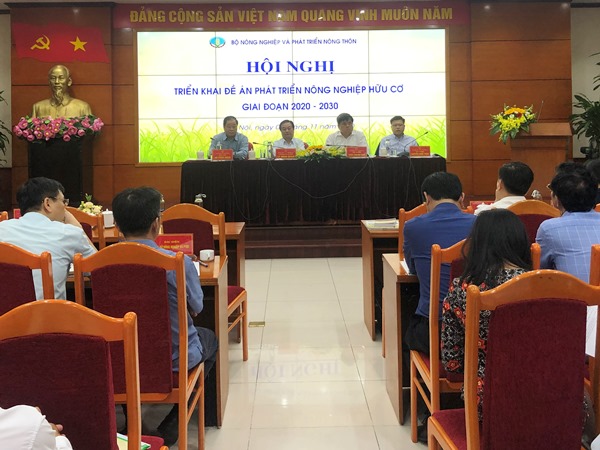
Ministry of Agriculture&Rural Development has advised the Government to promulgate the Scheme on development of organic agriculture in the period 2020-2030 in order to step by step turn Vietnam into a country with an organic agricultural production level equal to that of advanced countries. To do this, according to Deputy Minister Tran Thanh Nam, next to the area to continue to be intensive, Increasing productivity to ensure food security, each locality will base on the area of land, as well as key agricultural commodities to direct the development of organic agriculture. Other way, Provinces also need to focus on training and improving production capacity so that cooperatives and households implementing organic agriculture models understand how organic agriculture is., standards and regulations like. Therefore, after this batch, The staff will organize training courses to improve the qualifications of managers at all levels from the department, organic standards at the local level and producer, especially the Vietnamese Standard 11041:2017 – The national standard for organic agriculture.
In addition, the Ministry of Agriculture and Rural Development will guide the production processes towards organic agriculture and organic agriculture standards to each locality.. Because, The investment process to convert from conventional production to organic farming is very expensive, Not anywhere can do it, should be implemented step by step.
Another issue emphasized by Deputy Minister Tran Thanh Nam, That is how to coordinate with industries in the management of organic agricultural products when placing labels on the market., quality. “Just past, We tried to find out some places that showed that there were items that were labeled organic but not certified organic agriculture.. This is a current problem that needs to be rectified. This is not the only one of MARD&Rural development can do that requires branches, especially market regulators are involved in coordination”.
So, next time, The Department will provide legal support, facilitate to help domestic organic certification bodies to improve their capacity while also orienting them to link with international certification bodies to step by step enhance their position., level, The capacity of domestic certification bodies is equal to that of other countries in the region and in the world.
Source: Ministry of Agriculture&PTNT

